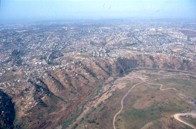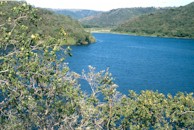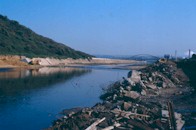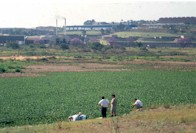|
|
| RHP |
South African
River Health Programme
|
State of the Rivers Report
uMngeni River and Neighbouring Rivers and Streams
|
|
The uMlazi River originates south west of Pietermaritzburg at 1 500m above sea level. In the upper uMlazi, the main land-use types are agriculture, forestry and small rural and peri-urban settlemements. The river flows through the Baynesfield and Mapstone dams before entering the Tala Valley, an area of intense commercial agriculture and isolated forestry. From here, the river flows into Thornlea Dam, through the Killarney valley and Mpumalanga settlement and into Shongweni Dam. Here the river is joined by the Sterkspruit and Wekeweke tributaries. Below Shongweni Dam, the river runs through steep sided valleys and then through rural areas downstream of Dassenhoek. It then flows through the densely populated areas of Chatsworth, uMlazi town and the industrial zone near Durban airport (historically a large swamp) before flowing out to sea through a concrete canal. The population of the uMlazi catchment is 690 800.
|

|
Water quality of the uMlazi is Good, but deteriorates to Poor in the lower reaches.
Riparian habitat is Good in the upper reaches, but invasive alien plants are a major problem especially in the lower reaches, despite control efforts. The riparian zone is also affected by heavy stock grazing.
Instream habitat is Natural in the upper reaches aided by removal of alien plants from the banks. In the lower reaches of the uMlazi and the Sterkspruit below Hammarsdale, the instream habitats are only Fair, largely due to excessive nutrient input.
Invertebrates upstream of Shongweni Dam are in Good condition due to the presence of several pollution sensitive species.
Fish are in Good condition but Fair in the middle reaches and Poor in the sea. The biota of the Sterkspruit are in Poor condition.
|
|
Regulation of river flow by impoundments.
Abstraction for irrigation (upper uMlazi) and water use by plantation forests.
Excessive industrial (in particular Hammarsdale and Isipingo) and nutrient inputs (mainly by agricultural activities in the upper catchment and 4 wastewater works in the middle and lower catchments) to the river leading to eutrophication (excessive nutrient enrichment of water).
Rampant aquatic weed growth.
Sand mining for construction purposes.
Rapid urbanization (e.g. Mpumalanga and lower uMlazi), with increasing population densities and inadequate services, leading to increased contaminated runoff and faecal pollution from residential areas (e.g. KwaNdengezi and Dassenhoek) and informal settlements.
Surcharging sewers in the lower catchment.
Canalisation of the uMlazi River in the lower reaches and loss of the original estuary.
|

|
Supply of good quality water mainly to formal agriculture and forestry in the upper reaches and Tala Valley; also for small-scale agriculture and rural settlements.
Subsistence and sport fishing in rivers and dams.
Tourism and trade, based on presence of river (and dams), their scenic value and opportunities for water-based activities: e.g. game viewing and canoeing on and around e.g. Shongweni Dam and Resources Reserve.
River-based education activities abound in this catchment.
Assimilation and transport of pollutants from agriculture, the domestic sector and industry.
Sand mining (below Shongweni Dam)
|
|
Improved industrial, domestic and agricultural pollution control.
Integrated approach to aquatic weed management.
Continued support for riparian weed eradication efforts initiated by the Working for Water Programme. This needs to be extended to shrub species in the lower reaches.
Appropriate operating rules for water releases from all the larger dams, to improve the health of downstream river ecosystems and thus improve the levels of goods and services provided by the river.
Manage sewer surcharges in the lower reaches.
|

|
|
Due to its location between the port of Durban and the Gauteng region, the uMngeni and uMlazi catchments are traversed by road, rail and pipeline routes, which carry huge amounts of hazardous cargo. Large quantities of such materials are also used or produced by the many industries in the Durban-Pietermaritzburg area. Spills of hazardous materials from either transport accidents or industries therefore pose a significant threat to human health and the environment.
Owing to the range of materials being transported and used almost every kind of pollution threat is possible. Hydrocarbons, pesticides, heavy metal compounds, acids, alkalis have all been transported in quantity through these catchments. Substances such as salt, sugar, vegetable oil, molasses and milk, are not toxic in small amounts, but if tons of these materials end up in rivers, serious environmental damage can and does occur.
Effective response protocols have been developed and the expertise to respond to spills is well developed. However, clear understanding of the threat by industrial producers and catchment residents is still lacking.
|
| SOUND CATCHMENT MANAGEMENT PRACTICES
|
|
|
Improvement in agricultural and forestry practice (e.g. harvesting activities, riparian zone management and invasive alien plant control in partnership with the Working for Water Programme) in the upper uMlazi has been dramatic. Despite intense agriculture in the Tala Valley reduction in the use of pesticides and fertilizers have contributed to moderately good river health scores.
Active river and land management committees have been formed, especially in upper uMlazi (under the guidance of the Umlaas Irrigation Board) and Tala valley. These focus on pollution control and in particular riparian zone aspects of river management.
A culture of 'river care' and a high level of awareness and action in both formal (e.g. agricultural) and informal (rural community) sectors (e.g. Entembeni community involvement in alien plant clearing and rehabilitation of river banks) have resulted in actions that promote improved river and catchment management.
|
| WATER WEEDS IN THE UMLAZI CATCHMENT
|
|

|
The growth of water weeds has a significant impact on river health and reduces the benefits that people could derive from a more healthy river ecosystem. In Thornlea Dam in the Tala Valley, the spread of water hyacinth has been brought under control through manual removal by landowners and by biological control (i.e. using the plant's natural enemies). However, in the mid-section of the catchment there is a serious aquatic weed problem, exacerbated by high nutrient levels from agricultural fertilizers and the wastewater works. Water hyacinth are well established near Mpumalanga, although they have been vigorously attacked by the biocontrol agents.
|
|
The Hammarsdale Dam on the Sterkspruit tributary is a major breeding ground for this weed. This infestation has been the subject of much controversy and is being used by the Plant Protection Research Institute to raise biocontrol agents that attack and feed on the weeds, for distribution to other parts of the country.
Although the biological control agents are thriving, because of the high nutrient levels and the rapid growth of the plants they have not been able to reduce the weed population effectively. According to the Hammarsdale Industrial Conservancy, the plan is to use herbicides to kill the plants so that the dam can be used by the people of Hammarsdale.
Msinsi Holdings have achieved some success in combating hyacinth in Shongweni Dam using chemical control in a zero tolerance procedure. However, because of reinfestation from Hammarsdale upstream, they require ongoing management. There is also a massive infestation in the lower uMlazi River as it enters Durban, to the extent that at times the river disappears under a green blanket.
|
|